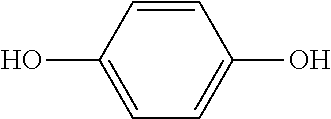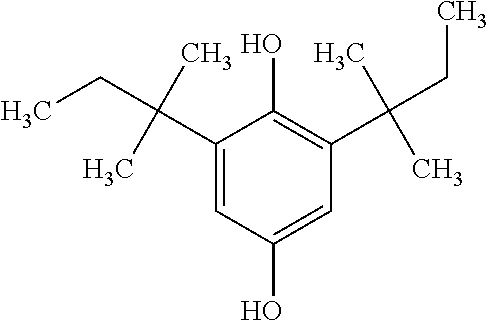Polyurethane Foam Scorch Inhibitor
a technology of scorch inhibitors and polypropylene oxide glycols, which is applied in the direction of other chemical processes, chemistry apparatuses and processes, etc., can solve the problems of less stable polypropylene oxide glycols than those based on polypropylene oxide glycols
- Summary
- Abstract
- Description
- Claims
- Application Information
AI Technical Summary
Benefits of technology
Problems solved by technology
Method used
Image
Examples
Embodiment Construction
[0009]A standard polyurethane foam formulation (Table A) was used to test representative scorch inhibitor blends. Other known foam formulations can be used as well:
TABLE ApartsPolyol100.00Distilled Water5.50L5770 Silicone (OSi)1.20A127 Amine Catalyst (OSi)0.47Fyrol FR2 (Akzo / Nobel)7.00Dabco T9 (Air Products)0.25Mondur TD80 Grade A TDI (Bayer AG)70.80Additive0.50
[0010]An embodiment of the scorch inhibitor of the invention is a multi-component liquid system comprising (in weight %):[0011](1) a phenolic compound or blend, from about 60-80% by weight. Examples of acceptable derivatized phenolics include: tetrakis[methylene(3,5-di-tert-butyl-4-hydroxyhydrocinnamate)]methane, iso-octyl-3-(3,5-di-tert-butyl-4-hydroxyphenyl)propionate, isotridecyl-3-(3,5-di-tert-butyl-4-hydroxyphenyl)propionate and 2,6 di-tert-butyl-4-nonyl phenol or 1,2-bis(3,5-di-tert-butyl-4-hydroxyhydrocinnamoyl)hydrazine or 2,2′-thiodiethylene bis[3-(3,5-di-t-butyl-4-hydroxyphenyl)propionate; i-octyl-3-(3,5-di-tert-but...
PUM
| Property | Measurement | Unit |
|---|---|---|
| temperatures | aaaaa | aaaaa |
| temperatures | aaaaa | aaaaa |
| weight | aaaaa | aaaaa |
Abstract
Description
Claims
Application Information
 Login to View More
Login to View More - R&D
- Intellectual Property
- Life Sciences
- Materials
- Tech Scout
- Unparalleled Data Quality
- Higher Quality Content
- 60% Fewer Hallucinations
Browse by: Latest US Patents, China's latest patents, Technical Efficacy Thesaurus, Application Domain, Technology Topic, Popular Technical Reports.
© 2025 PatSnap. All rights reserved.Legal|Privacy policy|Modern Slavery Act Transparency Statement|Sitemap|About US| Contact US: help@patsnap.com


